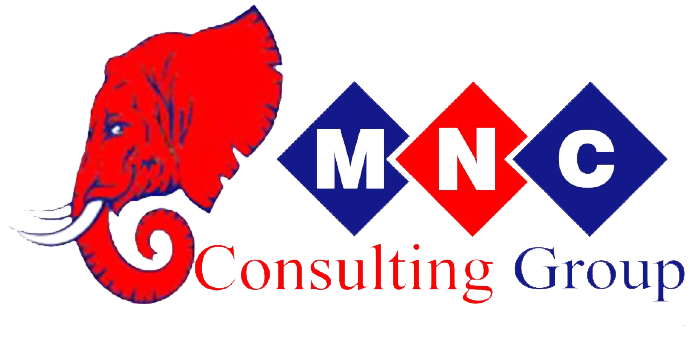- Home
- About
- Services
- Audit and Assurance
- Taxation in Kenya
- Human Resource Management
- Business Process Outsourcing(BPO)
- Consultancy and Advisory
- Management Advisory
- Assets and Investments Advisory
- Business Transformation and Turnaround
- Business Start-ups Incubation
- Family Business Advisory
- Financial Advisory
- Business and Corporate Strategy
- Property Advisory
- Business Valuation
- Business Plan Formulation
- Funding Proposals
- Mergers, Acquisition (M & A) and Restructuring
- Transaction Advisory Services
- Crisis Management
- Monitoring and Evaluation (M&E)
- Communication Services
- Industries
- Transportation
- Agriculture and Agribusiness
- Processing and Manufacturing
- Hospitality, Leisure and Tourism
- Construction and Real Estate
- NGOs and Charitable Trusts
- Distribution and General Trading
- Consultancy
- Financial Services
- Automotive Machinery & Equipment
- Water and Sanitation
- Healthcare
- Technology
- Energy, OIl, and Gases
- Betting and Gaming
- Education
- Resources
- Careers
- Contact us
- Login

Accelerating Company Growth through Mergers and Acquisition (M&A)
- April 14, 2021
- administrator
- Article
- 251 Comments
[vc_row][vc_column][vc_custom_heading source=”post_title” use_theme_fonts=”yes”][vc_column_text]What is merger and acquisition? Mergers and acquisitions (M&A) is basically consolidation of companies. Differentiating the two terms, Mergers is the combination of two companies to form one, while Acquisitions is one company taken over by the other. The reasoning behind M&A generally given is that two separate companies together create more value compared to being on an individual stand. With the objective of wealth maximization, companies keep evaluating different opportunities through the route of merger or acquisition. Major reasons for mergers and acquisition (M&A) 1.Synergy The most used word in M&A is synergy, which is the idea that by combining business activities, performance will increase and costs will decrease. Essentially, a business will attempt to merge with another business that has complementary strengths and weaknesses. 2. Diversification / Sharpening Business Focus These two conflicting goals have been used to describe thousands of M&A transactions. A company that merges to diversify may acquire another company in a seemingly unrelated industry in order to reduce the impact of a particular industry’s performance on its profitability. Companies seeking to sharpen focus often merge with companies that have deeper market penetration in a key area of operations. 3.Growth Mergers can give the acquiring company an opportunity to grow market share without having to really earn it by doing the work themselves – instead, they buy a competitor’s business for a price. Usually, these are called horizontal mergers. For example, a beer company may choose to buy out a smaller competing brewery, enabling the smaller company to make more beer and sell more to its brand-loyal customers. 4.Increase Supply-Chain Pricing Power By buying out one of its suppliers or one of the distributors, a business can eliminate a level of costs. If a company buys out one of its suppliers, it is able to save on the margins that the supplier was previously adding to its costs; this is known as a vertical merger. If a company buys out a distributor, it may be able to ship its products at a lower cost. 5.Eliminate Competition Many M&A deals allow the acquirer to eliminate future competition and gain a larger market share in its product’s market. The downside of this is that a large premium is usually required to convince the target company’s shareholders to accept the offer. It is not uncommon for the acquiring company’s shareholders to sell their shares and push the price lower in response to the company paying too much for the target company. Mergers & Acquisitions can take place: by purchasing assets by purchasing common shares by exchange of shares for assets by exchanging shares for shares Principle behind any M&A is 2+2=5 There is always synergy value created by the joining or merger of two companies. The synergy value can be seen either through the Revenues (higher revenues), Expenses (lowering of expenses) or the cost of capital (lowering of overall cost of capital). A Successful Merger is a Planned Merger: Ideally, you would start planning as soon as you decide to buy something. If you have no plan for the target company, you are going to pay the wrong price and you are not going to be ready to handle the integration. I would do a couple of days planning right at the start. At latest, I would start building a full integration plan around 100 days before you believe the deal will take place. Careless Acquisitions Causes Reverse Multiple Arbitrage: If you buy a company that doesn’t fit into your strategy, you may suffer from reverse multiple arbitrage since investors will no longer be able to identify your true brand or mission. An M&A is an arranged marriage There is no love at the beginning The issues start Day One Executives announce the once hush-hushed M&A information Employees pretend to be excited as FEAR ripples through both companies The C suite (senior executives) announces: “This will be great for everyone” No one is buying that promise Types of mergers and acquisition There are five commonly-referred to types of business combinations known as mergers: conglomerate merger, horizontal merger, market extension merger, vertical merger and product extension merger. The term chosen to describe the merger depends on the economic function, purpose of the business transaction and relationship between the merging companies. 1.Conglomerate merger A conglomerate merger is a merger between firms that are involved in totally unrelated business activities. There are two types of conglomerate mergers: pure and mixed. Pure conglomerate mergers involve firms with nothing in common, while mixed conglomerate mergers involve firms that are looking for product extensions or market extensions. 2.Horizontal Merger A merger occurring between companies in the same industry. Horizontal merger is a business consolidation that occurs between firms who operate in the same space, often as competitors offering the same good or service. Horizontal mergers are common in industries with fewer firms, as competition tends to be higher and the synergies and potential gains in market share are much greater for merging firms in such an industry. 3.Product Extension Mergers A product extension merger takes place between two business organizations that deal in products that are related to each other and operate in the same market. The product extension merger allows the merging companies to group together their products and get access to a bigger set of consumers. This ensures that they earn higher profits. 4.Vertical Merger A merger between two companies producing different goods or services for one specific finished product. A vertical merger occurs when two or more firms, operating at different levels within an industry’s supply chain, merge operations. Most often the logic behind the merger is to increase synergies created by merging firms that would be more efficient operating as one. 5. Market Extension Mergers A market extension merger takes place between two companies that deal in the same products but in separate markets. The main purpose of the market extension merger is to make sure that the merging companies…
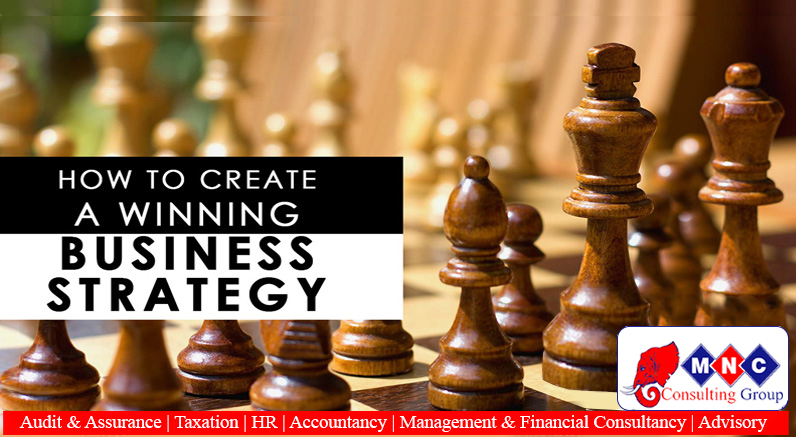
Creating a Winning Business Strategy
- April 7, 2021
- administrator
- Article
- 8 Comments
[vc_row][vc_column][vc_custom_heading source=”post_title” use_theme_fonts=”yes”][vc_column_text]Business strategy- What is it? What exactly is business strategy? In simple terms, a business strategy is an articulation of the overall direction of the business. Strategies that are identical to those of your competitors can result in the failure of your objectives. Business strategy can also be seen as a decision made at the highest levels of the company on positioning and direction. Such a decision serves to establish a clearly defined framework for subsequent decisions. Accordingly, strategy and decision-making become inseparable; without organizational competence for decision-making, the formulation of a strategy in itself does not have much meaning. Business strategy – Need and purpose The reason why having a strategy is so important is because it gives business time to get a sense of how they are preforming, what their capabilities are, and if these capabilities are able to help them grow. Developing a good business strategy is a thoughtful process. It takes a balanced approach to come up with a strong but flexible business strategy that can absorb change without disintegrating. Just as a good topographical map is indispensable to a hiker outlining explicit geographical hazards, so is a good business strategy to a company. It encompasses information on competitors and technology, suppliers and customers and provides directional guidance. Key principles about business strategy Business strategy compete to be unique, not to be the best Strategy is a pattern in a stream of decisions Business strategy compete for profit as it’s the aim of every business to make profit Know your industry before you develop your strategy Strategy is thinking about a choice and choosing to stick with your thinking The essence of strategy is choosing what not to do A good strategy requires you to keep moving because a good strategy is a sigh of success Key Components of a winning strategy plan Vision The CEO and senior management likely has a focused vision for the current and future of their organizations. It’s imperative that the executives include their shared vision into a successful business strategy. Mission Your mission statement should embody the values of the organization, to which you will always remain true. A good mission statement should include a clear, concise expression of the company’s purpose, philosophy and commitment. Objectives Along with your company’s short- and long-term goals, your objectives should state the specific objectives your business strategy will accomplish as well as a timeline outlining when management believes the company will reach them. In all cases, your company’s objectives should focus on achieving the broader goals as displayed in your mission statement. Strategies This is the how you will achieve your goals and objectives. While strategic planning groups often express different ideas of how to reach the outcomes your strategies target, brainstorming and free discussion typically results in agreement on a business strategy or strategies that should work. Even in smaller organizations, CEOs should try to involve as many people as possible. This is more important than just keeping everyone on the same page. You often learn that staff members have winning ideas that need to be considered. Perhaps more important, though, is that inclusion creates buy-in, and any winning strategy will need engaged employees to be successful. Action Plans Clearly, great vision and mission statements are useless if not acted upon. Action plans are the engines that make strategic plans succeed. Creating detailed action plans that include what is to be done, who is accountable for it, and when it is due, is an ingredient commonly glossed over in strategic planning. Too many organizations create outstanding strategies without attaching specific action plans, and so they gather dust until the next strategic planning meeting. Type of strategy 1.Generic or general strategy Strategy, in general, refers to how a given objective will be achieved. Consequently, strategy in general is concerned with the relationships between ends and means, that is, between the results we seek and the resources at our disposal. Strategy and tactics are both concerned with formulating and then carrying out courses of action intended to attain particular objectives. For the most part, strategy is concerned with deploying the resources at your disposal whereas tactics is concerned with employing them. Together, strategy and tactics bridge the gap between ends and means. 2. Corporate strategy The overall scope and direction of a corporation and the way in which its various business operations work together to achieve particular goals. Corporate strategy defines the markets and the businesses in which a company will operate. It is typically decided in the context of defining the company’s mission and vision, that is, saying what the company does, why it exists, and what it is intended to become. 3. Competitive strategy It’s defined as the long-term plan of a particular company in order to gain competitive advantage over its competitors in the industry. It is aimed at creating defensive position in an industry and generating a superior ROI (Return on Investment). Such type of strategies plays a very important role when industry is very competitive and consumers are provided with almost similar products. Before devising a competitive strategy, one needs to evaluate all strengths, weaknesses, opportunities, threats in the industry and then go ahead which would give one a competitive advantage. Types of competitive strategies a. Cost Leadership Here, the objective of the firm is to become the lowest cost producer in the industry and is achieved by producing in large scale which enables the firm to attain economies of scale. High capacity utilization, good bargaining power, high technology implementation are some of factors necessary to achieve cost leadership. b. Differentiation leadership Under this strategy, firm maintains unique features of its products in the market thus creating a differentiating factor. With this differentiation leadership, firms target to achieve market leadership. Superior brand and quality, major distribution channels, consistent promotional support etc. are the attributes of such products. c. Cost focus Under this strategy, firm concentrates on specific market segments and keeps its products…

The Joy and Excitement in Entrepreneurship
- March 31, 2021
- administrator
- Article
- 6 Comments
[vc_row][vc_column][vc_custom_heading source=”post_title” use_theme_fonts=”yes”][vc_column_text]What is entrepreneurship? Entrepreneurship is described as the “capacity and willingness to develop, organize and manage a business venture along with any of its risks in order to make a profit” The people who engage in the entrepreneurship process are called entrepreneurs. Reasons for engaging in entrepreneurship Control: Entrepreneurs want to be their own boss; Ambition: Entrepreneurs want to start something from scratch and develop it; and Financial: Entrepreneurs see an opportunity to earn more money Requirements of becoming successful in entrepreneurship Strong will, endurance and patience; A business concept or idea involving a product, service, process, or new technology; A business plan that breaks down the idea into processes and phases; People to support the work, whether as employees, vendors, or advisors; A process by which the product or service will be delivered, or the technology will be developed; and Enough money to support the development of the idea to the point that it generates revenue. Factors to consider when deciding the kind of entrepreneurship to venture in In considering what kind of business to start, an entrepreneur needs to assess: Their interests; Their background and experiences; Their financial resources; Unmet market needs; Problems they can solve; and Their network and connections. The benefits of entrepreneurship 1. It gives a great amount of freedom If you start your own business, you will be able to make your own demands and set your own schedule. You dictate everything you do, giving you a level of freedom that is not possible in formal employment. 2. Give rise to self-actualization: You believe in what you do Working in entrepreneurship is inspiring. Instead of being a component in the wheel for a giant, hierarchical corporation, you are able to see your ideas make a difference and contribute to the construction of a brand-new business. 3. It can be exciting Entrepreneurship can be very exciting, with many entrepreneurs considering their ventures highly enjoyable. Every day will be filled with new opportunities to challenge your determination, skills and abilities. 4. It allows you to set your own targets and returns You will be the one setting your own wage and making investments when you own the business. You could end up significantly increasing your income. 5. It offers flexibility. As an entrepreneur, you can schedule your work hours around other commitments, including quality time you would spend with your family and/or friends. 6. Gives a chance to choose your work environment Don’t expect to always be working from inside an office while working for or creating your own start-up. Entrepreneurs and other start-up founders often work from home or while traveling, instead of within an office. This is a great way to be able to experience a change in scenery and break up the monotony of always working in the same space. 7. You get to see your work change the society Part of what an entrepreneur does is solve problems. They make something more efficient, provide a better service or build a new product that helps people in their everyday lives. 8. You become an opinion maker and a business leader Being able to see how your business has contributed to the local economy and provided jobs is incredibly rewarding. Your role as a business leader in your community is important and respectable. Reason of failure in entrepreneurship The entrepreneur may lack the patience to wait until the business is established The business need to be given adequate time to establish itself and start building profits. Lack of a business plan hence poor planning Without a business plan it is not easy to identify potential problem areas and so chances of failure are higher. Poor financial planning may lead to failure of the business venture If the venture is under-priced, the company will not be able to maintain operational expenses and eventual it fails. If it is over estimated and there is too much money available, chance of misusing it are high. It requires you to dedicate a huge amount of time One big challenge in starting your own business is the amount of time you have to invest in it. For it to be successful, you have to take a level of time commitment that many people are just not willing to make. It can be difficult to compete with other businesses It is very important for an entrepreneur to stay competitive. This means that you have to differentiate your business from others in your niche in order to build a solid customer base and, finally, become profitable. It does not guarantee 100% success Entrepreneurship would make your dreams come true, which does not often happen with traditional employment, but you need to make some sacrifices to make it happen. However, the venture does not guarantee 100% success. It comes with unpredictable work schedules One major drawback of being an entrepreneur is that more work and longer hours will be required from you than being an employee. Some entrepreneurs give up after experiencing this. About the Author Thank you for reading this article. The author, James Ndambiri is an avid Business Advisor and Consultant: A Tax Surgeon, Proficient Accountant, Skilled Auditor, a Guru in Financial and Investment management, Expert in Business Strategy Formulation, Business Transformation Wizard, Family Business Advisor, Lecturer, Business Coach and a Family Man. James is the Founder, Team Leader, CEO & Managing Partner of MNC Consulting Group. MNC Consulting Group is your most trusted and respected professional business consulting firm recognised by our clients for delivering excellent business advisory and consulting services that create value to their ventures. With our focus set on value addition, we offer our clients the highest quality professional services in Accounting, Audit and assurance, Tax, Business Transformation, Investments and Financial Advisory, Family Business Advisory, Company Secretarial Services and Property Management that addresses their business needs through attracting, recruiting and retaining knowledgeable and passionate professionals who enable…
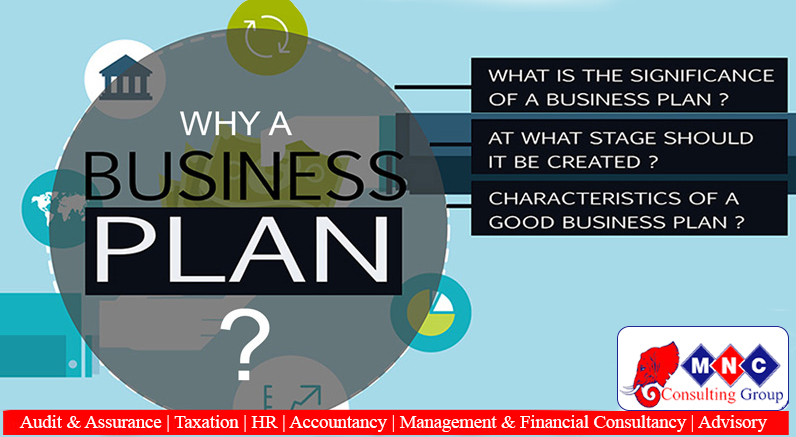
Why a Business plan?
- March 24, 2021
- administrator
- Article
- 4 Comments
[vc_row][vc_column][vc_custom_heading source=”post_title” use_theme_fonts=”yes”][vc_column_text] What is a business plan? A business plan/business proposal is a document that presents an investment idea in writing. It gives a step-by-step outlay of the activities to be undertaken. It is a formal statement of business goals, reasons they are attainable, and plans for reaching them. It’s a tool for understanding how your business is put together. You can use it to monitor progress, hold yourself accountable and control the business’s fate. Composition of a business plan? Executive Summary: It gives a brief description of the whole business idea. Background Information: It gives a brief overall history. It talks about the origin or dynamics in the growth of the business and the industry. Project concept: What entails the business activity? It talks about the projects and gives project details regarding the; Why, when, where and how Technical Aspects: It explains the type and specifications of the machinery that will be used for production and whether or not the firm has the required technical capability in relation to operating the machinery. Raw Materials and Other Inputs: The basic production components i.e. what goes into producing the final product? Organization and Management: Explains the organization structure and management and how effective they are. Marketing and Market Analysis: Plans to create demand for the product. Sales Strategies: How to achieve desired sales by satisfying the demand. Funding Requirements: The capital required to start and run the business. Financial Projections: Estimates of the future financial performance of the business. Economic Analysis: It is an analysis of the economic impact of the business venture on the other businesses and the general society around it. Risk Assessment: What are the chances of failure, or the opportunities available? Environment, Social and Gender Issues: The impact of the business on the environment, corporate social responsibility and the inclusion of both gender. Users of a business plan? The entrepreneur who are intending to start a business venture. Financial institutions. To determine the funding requirements and the proposed funding utilization strategy in order to determine the credit worthiness of the borrower. The company management. Acts as a guide for the implementation of the project. Potential investors or business partners. Evaluate the business and decide whether to invest or not. Company employees. Helps the company to have a sense of direction. Purpose of a business plan When establishing a new business: The plan is used to establish the right steps to starting a new business, including what you need to do, what resources will be required, and what you expect to happen. Grow your existing business: Help establish a strategy and allocate resources according to strategic priority. It is a tool to secure funding: Banks and most of the credit offering facilities will consider offering you a business loan only with a properly done business proposal (mostly in manufacturing). Know if, when, and how you are making money: The business plan indicates when income and expenses are expected. This makes it easier for an investor to plan for limited operational finances. Share and explain business objectives with your management team, employees, and new hires: Makes selected portions of your business plan part of your new employee training. A map for the future: Business plan gives a detailed description of all that needs to be done in order to get to the set destination. There is a sequence of activities. The business plan shows strategic ways to market the product or service being offered: It enables analyzing the market which in turn helps set up strategies on how to induce demand. A guide for decision making: A business plan can prevent you from making a hasty decision that leads you astray. This helps to avoid time and resource wastage. Recruitment: A business plan helps you identify the employees’ requirements hence enabling fill the gaps. Manage Company: A business plan conveys the organizational structure of your business, including titles of directors or officers and their individual duties. This enables everyone to have their targets outlined properly. Help manage bootstrapping financing: Help start-up a business from scratch and build it up with minimal outside investment and finances. Sell your business: Usually, a business plan is a very important part of selling the business. Help buyers understand what you have, what it’s worth and why they should it over it. Valuation of the business for formal transactions related to divorce, inheritance, estate planning and tax issues: Valuation is the term for establishing how much your business is worth. Usually that takes a business plan, as well as a professional with experience. The plan tells the valuation expert what your business is doing, when, why and how much that will cost and how much it will produce. About the Author Thank you for reading this article. The author, James Ndambiri is an avid Business Advisor and Consultant: A Tax Surgeon, Proficient Accountant, Skilled Auditor, a Guru in Financial and Investment management, Expert in Business Strategy Formulation, Business Transformation Wizard, Family Business Advisor, Lecturer, Business Coach and a Family Man. James is the Founder, Team Leader, CEO & Managing Partner of MNC Consulting Group. MNC Consulting Group is your most trusted and respected professional business consulting firm recognized by our clients for delivering excellent business advisory and consulting services that create value to their ventures. With our focus set on value addition, we offer our clients the highest quality professional services in Accounting, Audit and assurance, Tax, Business Transformation, Investments and Financial Advisory, Family Business Advisory, Company Secretarial Services and Property Management that addresses their business needs through attracting, recruiting and retaining knowledgeable and passionate professionals who enable us to deliver superior results while contributing positively to the community in which we live and work. Make us your business partner by always consulting with us. ‘‘With us, you are in safe hands’’[/vc_column_text][/vc_column][/vc_row]
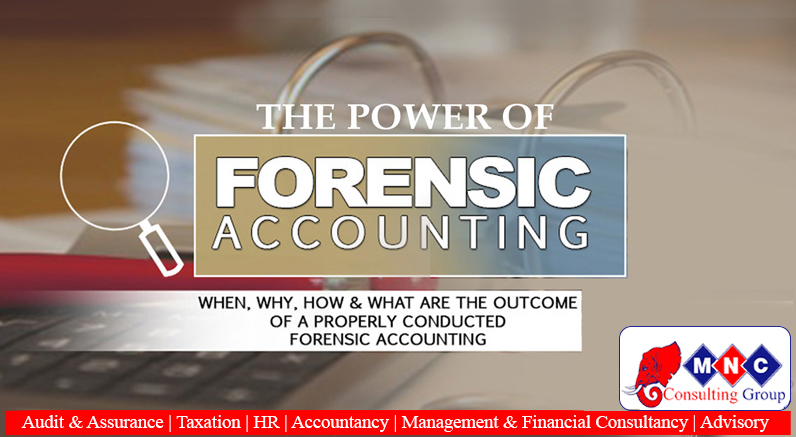
The Power of Forensics Accounting
- March 17, 2021
- administrator
- Article
- 10 Comments
[vc_row][vc_column][vc_custom_heading source=”post_title” use_theme_fonts=”yes”][vc_column_text] What is Forensic Accounting? It’s the specialty practice area of accounting that describes engagements that result from actual or anticipated disputes or litigation. “Forensic” means suitable for use in Court, and it is to that standard and potential outcome that forensic accountants generally have to work. Forensic accountants give expert evidence at the eventual trial by utilizing their accounting and auditing skills, and using their investigative skills to determine when and what events actually took place in a certain financial setting. Forensic Accounting encompasses two main broad areas: Litigation Provision – Litigation represents the factual presentation of economic issues related to existing or pending litigation. In this capacity, the forensic accountant quantifies damages sustained by parties involved in legal disputes and can assist in resolving disputes before they reach the courtroom. If a dispute reaches the courtroom, the forensic accountant may testify as an expert witness. Knowledge of the courtroom sets the forensic accountant apart from a typical accountant. Investigation – Investigation is the act of determining whether criminal matters such as employee theft, securities fraud (including falsification of financial statements), identity theft, or insurance fraud have occurred. Investigation may also occur in civil matters. A forensic accountant may be hired to search for hidden assets in a divorce case. Engagements relating to Forensic Accounting may fall into several categories; Absence of a complete set of financial records – Forensic Accounting assists to reconstruct financial information when complete set of financial records are not available. For instance, when the financial records have been destroyed and when converting cash basis accounting records to accrual basis accounting and so forth. Shareholders’ and Partnership Disputes – These assignments often involve a detailed analysis of numerous years accounting records to quantify the issues in dispute. For example, a common issue that often arises is the compensation and benefits received by each of the disputing shareholders or partners. Business Interruption / Other Types of Insurance Claims – Insurance policies differ significantly as to their terms and conditions. Accordingly, these assignments involve a detailed review of the policy to investigate coverage issues and the appropriate method of calculating the loss. Examples of these types of forensic accounting assignments include; business interruptions, property losses and employee dishonesty (fidelity) claims. Business/Employee Fraud Investigations – Business investigations can involve funds tracing, asset identification and recovery, forensic intelligence gathering and due diligence reviews. Employee fraud investigations often involve procedures to determine the existence, nature and extent of fraud and may concern the identification of a perpetrator. Criminal Investigations – Engagements relating to criminal matters typically arise in the aftermath of fraud. They frequently involve the assessment of accounting systems and accounts presentation – in essence assessing if the numbers reflect reality. Forensic accountants may be involved in recovering proceeds of crime and in relation to confiscation proceedings concerning actual or assumed proceeds of crime or money laundering. Matrimonial Disputes – Matrimonial disputes from a Forensic Accounting point-of-view often involve the tracing, locating and evaluation of assets. The assets may be businesses, property or other assets and were owned or were under the management of the partners. Business Economic Losses – Examples of assignments involving business economic losses include; contract disputes, construction claims, expropriations, product liability claims, trademark and patent infringements and losses stemming from a breach of a non-competition agreement. Professional Negligence – Forensic accountants often assist in professional negligence claims where they are assessing and commenting on the work of other professionals. These investigations are often approached from two different but complimentary perspectives, these being: Technical – This is when the professional in question has a breach of Generally Accepted Accounting Principles or Generally Accepted Auditing Standards or other standards of practice occurred; and Loss Quantification – If the professional in question is an accountant then a Forensic Accountant could be involved with both perspectives. If the matter involves some other profession a Forensic Accountant will normally be retained to perform only a loss quantification. Conclusion While forensic accounting and fraud auditing are related, fraud auditing is more anticipatory. Fraud auditors try to control a situation before something happens, whereas a forensic accountant may be hired after the fact. A forensic accountant is usually hired after a company suspects’ theft, fraud or embezzlement. Forensic accountants are suspicious. They must be able to apply their accounting knowledge to legal issues. A forensic Certified Public Accountant will be asked to write expert reports, assist in depositions, testify as an expert witness, conduct fraud investigations and assist in civil and criminal investigations. About the Author Thank you for reading this article. The author, James Ndambiri is an avid Business Advisor and Consultant: A Tax Surgeon, Proficient Accountant, Skilled Auditor, a Guru in Financial and Investment management, Expert in Business Strategy Formulation, Business Transformation Wizard, Family Business Advisor, Lecturer, Business Coach and a Family Man. James is the Founder, Team Leader, CEO & Managing Partner of MNC Consulting Group. MNC Consulting Group is your most trusted and respected professional business consulting firm recognized by our clients for delivering excellent business advisory and consulting services that create value to their ventures. With our focus set on value addition, we offer our clients the highest quality professional services in Accounting, Audit and assurance, Tax, Business Transformation, Investments and Financial Advisory, Family Business Advisory, Company Secretarial Services and Property Management that addresses their business needs through attracting, recruiting and retaining knowledgeable and passionate professionals who enable us to deliver superior results while contributing positively to the community in which we live and work. Make us your business partner by always consulting with us. ‘‘With us, you are in safe hands’’[/vc_column_text][/vc_column][/vc_row]
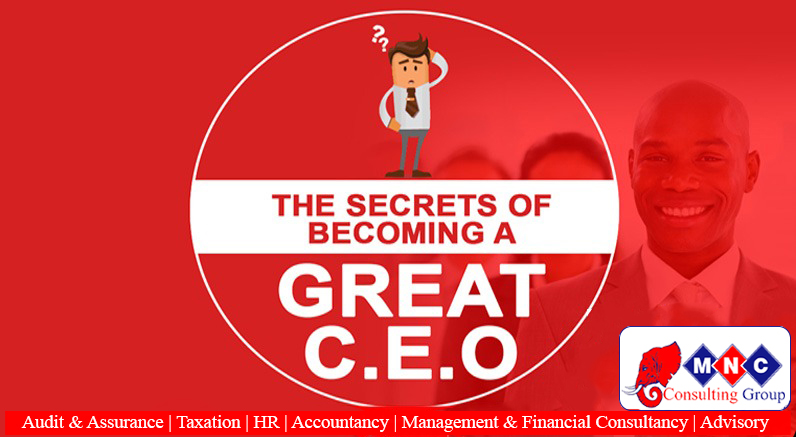
The Secrets of Becoming a Great CEO
- March 10, 2021
- administrator
- Article
- 6 Comments
[vc_row][vc_column][vc_custom_heading source=”post_title” use_theme_fonts=”yes”][vc_column_text] Who is a CEO? A chief Executive Officer (CEO) is the highest-ranking executive in a company, and his/her primary responsibilities include making major corporate decisions, managing the overall operations and resources of a company, and acting as the main point of communication between the board of directors and corporate operations. He/she takes part in day today running of the business and executes the policies and decisions of the board of directors. An organisation can have a CEO who is not a director but is engaged to run an organisation. However, where the CEO is also a shareholder and a director, he/she is referred to as the managing director, president or executive director depending with the type of organisation. Who does the CEO report to? The CEO reports to the Board of Directors. What is the work of a CEO? The responsibility of a CEO is to devise strategies and policies that ensure an organization meets its goals and objectives. His/her primary tasks include making major corporate decisions, managing the overall operations and resources of a company and acts as a direct liaison between the Board and management of the company and communicates to the Board on behalf of management. He plans, directs, and coordinates operational activities of a company. The CEO sets the vision and mission for the organisation. SEVEN KEY TRAITS OF A GREAT CEO Understand the responsibility of a CEO CEOs have five key responsibilities, no matter the company’s size, industry or geography. Only the Chief Executive Officer who has a holistic view of the firm can take on these duties: Own the vision As the CEO you should determine and communicate the organization’s strategic direction. Until that’s settled, making decisions about anything else at the business is difficult. And without this, the company is merely a collection of people pursuing individual goals, guided by their own values. While other people may help shape the strategic vision, the CEO must be able to describe it in a clear, engaging and exciting way for all stakeholders. Provide the proper resources Only the CEO can perform the task of balancing resources, the two most important ones being capital and people. The CEO must make both available in the proper quantities and at the right time for the company to succeed. Build the culture Culture is the set of shared attitudes, goals, behaviors and values that characterize a group. It adds up to how things get done in a company and influences the entirety of the employee experience and thus the customer experience. Every organized group of individuals develop a culture, whether it’s explicitly recognized or not and the CEO must constantly observe and be involved to achieve the desired culture. Make good decisions A new CEO is often surprised by the breadth of issues confronting him (or her). One minute the CEO is discussing a new product, the next a human resources issue and then along comes a legal issue. It’s impossible for anyone to be an expert in all aspects of the business, yet the CEO is the person tasked with making the decisions. Many problems require a solution that will end up affecting multiple departments, and only the CEO is empowered to take such an action. Everyone else can pass the buck from time to time, but the CEO will make the final call when no one else will or can. Oversee and deliver the company’s performance Everyone agrees that the CEO is ultimately responsible for a company’s performance. To be successful, you must take an active role in driving that performance. This requires maintaining a keen awareness of the firm’s industry and market and being in touch with the core business functions to ensure proper execution of tasks. Spend extra time learning For you to make wise decisions for a company a strong base of knowledge in the following fields is advocated for: finance, marketing, accounting, operations, procurement, strategy and human resource management. A great CEO never stops increasing and honing his or her knowledge. He can achieve this by attending seminars, workshops, school, reading etc. Can one become a great CEO without formal education? You can of course become a great CEO with only basic formal education. However, you will be required to polish up your skill through on job training. Build a good and powerful network The most successful Chief Executive Officers know that no one ever succeeds alone. You understand how valuable a professional network is in attaining success and achieving personal and professional goals. You should value the relationships you have cultivated over the years. By virtue of your position, you must be on top of what’s occurring in the company at all times, and be able to monitor and assess the financial health of the organization. You should know that a network with the right kind of contacts allows you to accelerate problem-solving and decision-making, and broaden your influence because you have access to private information, diverse thought, and a variety of skills set and power – the right person to connect with in any given situation is just a phone call away. The most successful CEOs are pros at networking and they know how to do it effectively. As a CEO you should also know that networking is about relationships, so you give before you ask. And because you are super busy, you should understand the power of leveraging your professional network of contacts. For you, it’s not about quantity, but the quality of your contacts. In your networks, you should have a few connectors who can significantly expand your professional reach. You may not attend networking events, but are members of professional groups where you can discuss issues and challenges with your contemporaries. The ability to network effectively is one of the most powerful tools that you can use to advance in your career. In your already over-scheduled day, learn how to network like CEOs and strategically build your network of contacts – making sure that you are connected to a…
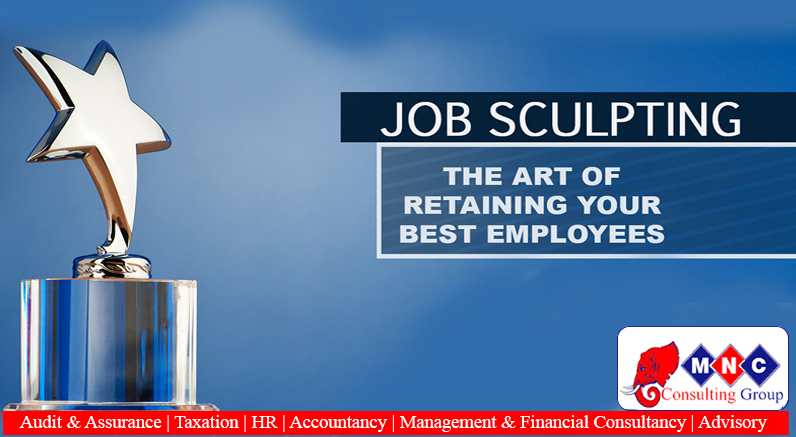
Job Sculpting: The Art of Retaining your Best Employees
- March 3, 2021
- administrator
- Article
- 7 Comments
[vc_row][vc_column][vc_custom_heading source=”post_title” use_theme_fonts=”yes”][vc_column_text]What is job sculpting? Job sculpting is the art of matching people to jobs that allow their deeply embedded life interests to be expressed. It is the art of forging a customized career path in order to increase the chance of retaining talented people. It is deeply embedded in life interests that are long-held, emotionally driven passions, intricately entwined with personality and thus born of unspecified mix of nature and nurture. Job sculpting techniques Ask employees to play an active role in job sculpting, perhaps by having them write about their views of career satisfaction an excellent starting point for a discussion. In some cases, sculpting can begin simply by adding a new responsibility. An Accountant who has a deeply embedded life interest in counseling and mentoring might be asked to plan and manage the orientation of new hires. A change in assignment provides another sculpting opportunity. A Marketer with an interest in quantitative analysis might be given new duties working with market research analysts. Managers should have a strong interest in the motivational psychology of their employees. In fact, they should openly express their willingness to help sculpt their employees ‘careers and to make the extra effort required to hold onto talented people. Even greater sculpting changes are sometimes required for example, when a manager can only meet a worker’s interests with a transfer to another department. In other cases, amicable separation is necessary, as when an Accounting firm has no job for an employee with a life interest in influence through language and ideas. Importance of job sculpting It keeps people engaged, and keeps them off from quitting. It is the art of forging a customized career path in order to increase the chance of retaining talented people. It creates happiness at work which often translates into commitment in employees’ areas of work. It creates good opportunities for advancement at work. Business core functions that represent the way deeply embedded life interests find expression in business Application of Technology: Whether or not they are actually working as or were trained to be engineers, people with the life interest application of technology are intrigued by the inner workings of things. They are curious about finding better ways to use technology to solve business problems. Quantitative Analysis: Some people aren’t just good at running the numbers, they excel at it. They see it as the best, and sometimes the only, way to figure out business solutions. Similarly, they see mathematical work as fun when others consider it drudgery, such as performing a cash-flow analysis, fore-casting the future performance of an investment instrument or figuring out the best debt/equity structure for a business. They might also enjoy building computer models in order to determine optimal production scheduling and to perform accounting procedures. Theory Development and Conceptual Thinking: For some people, nothing brings more enjoyment than thinking and talking about abstract ideas. People with this interest can be excited by building business models that explain competition within a given industry or by analyzing the competitive position of a business within a particular market. Our research also shows that people with this deeply embedded interest are often drawn to academic careers. Some end up there; many do not. Creative Production: Some people always enjoy the beginning of projects the most, when there are many unknowns and they can make something out of nothing. These individuals are frequently seen as imaginative, out of the box thinkers. They seem most engaged when they are brainstorming or inventing unconventional solutions. Indeed, they seem to thrive on newness. The reason creative production is one of their dominant deeply embedded life interest making something original, be it a product or a process. Counseling and Mentoring: For some people, nothing is more enjoyable than teaching in business, that usually translates into coaching or mentoring. These individuals are driven by the deeply embedded life interest of counseling and mentoring, allowing them to guide employees, peers, and even clients to better performance. People with a high interest in counseling and mentoring are also often drawn to organizations, such as museums, schools, and hospitals, that provide products or services they perceive to hold a high social value. People like to counsel and mentor for many reasons. Some derive satisfaction when other people succeed; others love the feeling of being needed. Regardless, these people are drawn to work where they can help others grow and improve. Managing People and Relationships: Longing to counsel and mentor people is one thng; wanting to manage them is another thing entirely. Individuals with this deeply embedded life interest enjoy dealing with people on a day to day basis. They derive a lot of satisfaction from workplace relationships, but they focus much more on outcomes than do people in the counseling and mentoring category. In other words, they’re less interested in seeing people grow than in working with and through them to accomplish the goals of the business, whether it is building a product or making a sale. That is why people with this life interest often find happiness in line management positions or in sales careers. Enterprise Control: Enterprise-control people are easy to spot in organizations. They seem happiest when running projects or teams, they enjoy “owning” a transaction such as a trade or a sale. These individuals also tend to ask for as much responsibility as possible in any work situation. Pure interest in enterprise control can be seen as an interest in deal making or in strategy a person with this life interest wants to be the Chief Executive Officer (CEO), not the Chief Operations Officer (COO). Investment bankers, for example, don’t run ongoing operations but often demonstrate a very strong interest in enterprise control. Influence Through Language and Ideas: Some people love ideas for their own sake, but others love expressing them for the sheer enjoyment that comes from storytelling, negotiating, or persuading. Such are people with the deeply embedded life interest of in-fluence through language and ideas. They feel most…

Effective Brand Building Strategies to Attract Customers
- February 24, 2021
- administrator
- Article
- 2 Comments
[vc_row][vc_column][vc_custom_heading source=”post_title” use_theme_fonts=”yes”][/vc_column][/vc_row][vc_row][vc_column][vc_column_text]What is a brand? Brand is a name, term, design, symbol, feature that identifies one seller’s good or distinct from those of other sellers’. What is Branding? Its is a set of marketing and communication methods that helps to distinguish company or product/services from competitors, aiming to create a lasting impression in the minds of customers. What is Brand Management? It is the analysis and planning on how that brand is perceived in the market. Developing a good relationship with the target market is an essential for brand management. What is Brand altitude? This refers to the buyers’ overall evaluation of a brand with respect to its perceived ability to meet currently relevant motivation. What is Brand Awareness? This is the extent to which customers can identify a brand under various conditions. Role of Branding in a Business Branding improves recognition; A major component of a brand is a logo. A good and professional logo design should be simple enough to be memorable and at the same time powerful enough to give the desired impression of your business. Branding creates trust; A professional appearance builds credibility and trust, this is because people are more likely to purchase from a business that appears polished and legitimate. Branding supports advertising; Advertising being another component of a brand, the group targeted for advertising and the medium chosen builds a brand. Branding builds financial value; The greater a company’s devotion to builds its brand value, the better the financial return. This is because a strong brand usually guarantees future business. Branding inspires employees; Many employees need more than just work, they need something to work towards. When employees understand your mission and reason for being, they are more likely to feel the same pride and work in the same direction to achieve the goals you have set. Branding generates new customers; Branding enables a company to get referral business. A positive word of mouth is only possible in a situation where a company has delivered a memorable experience with your customer. Attractive Branding Strategies (Brand Building) Define your brand; This step is critical as it ultimately determines what your company’s brand truly stands for. Also, the brand values are determined. The values should show that the firm is contributing to environmentally, social and well being of customers. Differentiate and position your brand; to differentiate the company’s brand, so that it can attract attention and at the same time stands out from competitors. Also, to differentiate your brand the company have to create a unique advantage in the minds of consumers not merely getting attention by brand building colors or logos or other superficial elements. Build and expose your brand; to build a brand, you have to keep on reinforcing your brand’s values and skills by taking up new roles and assignments that will give your company more exposure. Also, the company/firm can use promotional channels, blogs forums and social media to expose the company’s brand. Personalize your brand; if a company want its brand to be successful, then the company have to personalize its brand. It’s a way of giving a company an identity, so as to allow the consumers to see and experience the personality of the company brand. Review your brand; since a company brand is not static, it needs to go through a range of motions in its lifetime. Depending on strategies, the company brand will either grow in strength or remain dormant. Hence this calls for enhancing the value of the company brand or re-establishing it. Key Areas and Considerations in Branding Brand name selection; A good name can add greatly to the product/service success. Finding an appropriate brand name for a product/service begins with a careful review of the product/service and its benefits, target market, and proposed marketing strategies. The brand name should have the following characteristics; It should suggest something about the product/service benefits and qualities. It should be easy to pronounce and remember. The brand name should be distinctive. The name should translate easily into foreign languages. Some names may not be desirable when translated in to other languages. It should be capable of registration and legal protection. Brand sponsorship; Brand sponsorship options includes; Manufacturer’s brand; The product/service bears the name of the manufacturer e.g coca-cola, Mercedes Benz. Private brand; A brand created and owned by a reseller of product/service, for example where supermarkets repack and brand sugar, rice, flour. Licensing; the manufacturer licenses others to use their labels. Co-branding; the use of brand name of two or more different companies on the same product/service. Brand management; Brand management is aimed to achieve the following objectives; Brand focus for sustenance and growth. Competitive culture among sales and marketing team of a company. To build market share and consumer brand loyalty. As a profit centre. About the Author Thank you for reading this article. The author, James Ndambiri is an avid Business Advisor and Consultant: A Tax Surgeon, Proficient Accountant, Skilled Auditor, a Guru in Financial and Investment management, Expert in Business Strategy Formulation, Business Transformation Wizard, Family Business Advisor, Lecturer, Business Coach and a Family Man. James is the Founder, Team Leader, CEO & Managing Partner of MNC Consulting Group. MNC Consulting Group is your most trusted and respected professional business consulting firm recognised by our clients for delivering excellent business advisory and consulting services that create value to their ventures. With our focus set on value addition, we offer our clients the highest quality professional services in Accounting, Audit and assurance, Tax, Business Transformation, Investments and Financial Advisory, Family Business Advisory, Company Secretarial Services and Property Management that addresses their business needs through attracting, recruiting and retaining knowledgeable and passionate professionals who enable us to deliver superior results while contributing positively to the community in which we live and work. Make us your business partner by always consulting with us. ‘‘With us, you are in safe hands’’[/vc_column_text][/vc_column][/vc_row]

Creating Exceptional Customer Service
- February 17, 2021
- administrator
- Article
- 1,604 Comments
[vc_row][vc_column][vc_custom_heading source=”post_title” use_theme_fonts=”yes”][vc_column_text]Who is a customer? A customer is a person who is regarded as a king by a sales/marketing organisation as he/she buys goods/services or helps in the sales process to helps the goods to reach and be consumed by the end user. A customer is also referred to as a ‘MAN’, i.e. a person who has; M – Money A – Authority N – Need to satisfy What is customer service? Customer service is the act of taking care of the customer’s needs by providing and delivering professional, helpful, high quality service and assistance before, during, and after the customer’s requirements are met. Features of good customer service Customer service is the act of taking care of the customer’s needs by providing and delivering professional, helpful, high quality service and assistance before, during, and after the customer’s requirements are met. Customer service is meeting the needs and desires of any customer. Some characteristics of good customer service include: Promptness: Promises for delivery of products must be on time. Delays and cancellations of products should be avoided. Politeness: Politeness is almost a lost art. Saying ‘hello,’ ‘good afternoon,’ ‘sir,’ and ‘thank you very much’ are a part of good customer service. For any business, using good manners is appropriate whether the customer makes a purchase or not. Professionalism: All customers should be treated professionally, which means the use of competence or skill expected of the professional. Professionalism shows the customer that they’re cared for. Personalization: Using the customer’s name is very effective in producing loyalty. Customers like the idea that whom they do business with knows them on a personal level. Importance of a customer to an organisation The organisation exist to fulfill the needs of the customer hence without the customer organization cannot be there. Customers are a source of valuable information to organisation. Customers helps organisation to achieve its objectives such as profit sales maximization. Customers gives feedback to firms about their product and customer service. Customers helps to market organisations products especially when they give a positive word of mouth to other people about organisations products. Customers sustains an organisation through repeat purchase. When a customer expects a higher, better service but on return get a poor low service depending on his/her knowledge and experience with the retailer, making the customer to be dissatisfied hence leading to service gap. Service gap includes: Knowledge gap – This is the difference between the customer’s expectation of the customer service and the retailer’s perception of the customer’s expectation of the customer service. Standard gap – This is the difference between the retailer’s standard and the customer it sets. Delivery gap – This is the difference between the retailer’s set standards and the actual customer service offered. Communication gap – This the difference between the actual customer service offered and the customer service promised in the retailer’s promotion program. Performance gap – This is the difference between the performance promised/past performance by the retailer and the actual customer service. Solving the customer service gap Collect/gather information of the basic customer’s needs/requirement. Set standards to help deliver well the customer’s requirement. Develop programs to implement the set standards for a better customer requirement delivery. Communicate to customers of the service they should expect. Clues to help evaluate customer service Tangibles; for example, appearance of the sales people, display of the merchandise in the store, store display. Security; i.e. security in the parking lot, are the customers comfortable to transact in the store? Knowledge and understanding of customers; i.e., recognizing regular customers, responding to customers issues/complaints and suggestion. Access; ie, convenient location, convenient operating hours and access to managers to settle issues/complaints. Competence; that is, knowledgeable sales people, skillful and equipped service providers. Trustworthy; warranties and guarantees offered, trustworthy of the retailer’s staffs while giving change/balance, goods return policy. Courtesy; ie, interest shown to customers, how customers are treated by the retailer’s staffs and service providers. Nature of customer service Customer service is different from provision of merchandise in the following aspects; Intangible – A service unlike general merchandise can’t be evaluated by physical aspects such as colour, weight, size hence cannot be touched or seen. Inconsistent – A service provider may provide a higher/better service to one customer and a poor service to the next customer depending on the service provider’s moods, judgement, experience, educational level, emotions and feelings. Standardization and customization – standardization involves a strict adherence to as set of rules and procedures when delivering customer service while customization involves delivery of a superior service depending on the customer’s needs hence a satisfied customer leading to customer loyalty and a positive word of mouth. Types of customer service There are different types of customer service that are provided by businesses. The type of service that customers encounter will depend on the product or service that a business provides, what the customers’ needs are, and whether the service is problem-oriented or focused toward enhancing the consumer’s experience. Support: Support services include resolution of billing queries, order taking, activation of accounts, registration of new customers and recording complaints. Marketing: Marketing tasks carried out through a contact center include sending outbound emails, telemarketing, surveys and poling, responding to inbound emails and management of marketing campaigns. Sales: Sales tasks include inbound sales, outbound sales, web chat, web call-back and co-browsing. Technical Support: Customers require different technical support services such as data verification, application support, address updates and problem resolution through the technical help desk. Customer Analytics: Customer analytics includes profitability analytics, quality auditing, reporting and complaint analysis. Managing a conflict of interest in customer service In most organizations there exist a conflict of interest between the organization’s interest (profits, shareholders welfare) and the customer’s interest of a high better service hence to manage this conflict, the organization policies and goals should be aligned in such a way that they guarantee a better customer service. Customer service and complaints Organisations should encourage customers to table their complaints by establishing a customer desk where…
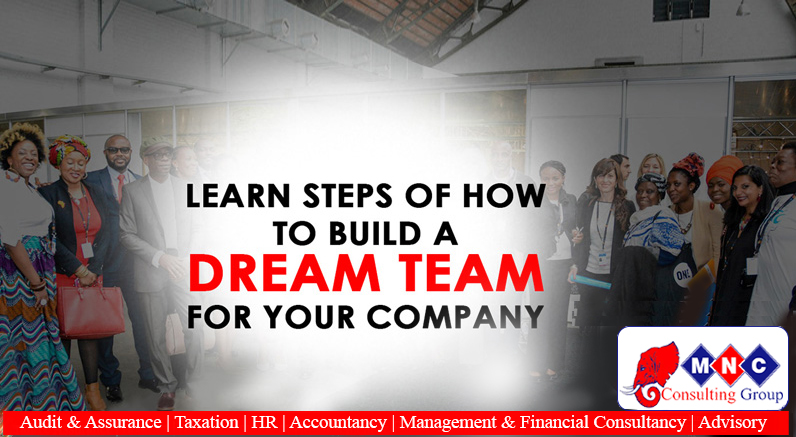
Building a Dream Team for Your Company
- February 10, 2021
- administrator
- Article
- 2 Comments
[vc_row][vc_column][vc_custom_heading source=”post_title” use_theme_fonts=”yes”][vc_column_text]What is a dream team? This is a number of persons of the highest ability associated in some joint actions. It is a team or a group whose members are among the most talented in their fields whose effort combined yield synergy that lead to increased output. Composition of a dream team Business Advisory Board (BAB); This is a group of local business and community leaders who are recruited by the owners of the business to serve as mentors. Their key role is: providing guidance and mentorship, introducing the entrepreneur to other business leaders in the community, suggesting project ideas, providing access to needed resources, funding opportunities, giving feedback on projects and presentation etc. They are able to guide you in the right direction and answer any question you might be having. The experts share their experience whether good or bad so that you can learn from their mistakes. The supporters; These are persons who supports you in thin and thick, when you have ideas and things you want to do, they are right there with you, helping you figure out things. The trailblazer; These are persons who always think outside the box, that is, comes up with new and exciting ways to do things. They keep up to date with technology and new techniques, and they won’t let things get out of stake. The trailblazers objectives/aim is to help you stay in the current. The disputer; these are persons who always brings you back to the earth because they view things and situations through from each and every angle. They don’t necessarily mean to pull down your idea but does make sure that all things are considered. The connectors; these are persons who know people, that is, social butterflies who know how to network. They always know someone to help you with what you need and are always happy to make the connection. The muscles; the muscle can help you set-up before an event and tear everything down afterwards. Technocrats; This are persons who are highly qualified, professional staff members who help you maneuver in business and help you reduce the risk of running the business buy use or trial and error method. They are selected on the basis of their expertise in their areas of responsibility and knowledge e.g. accountants, lawyers etc. Steps of building a dream team The following are some of the steps of developing a successful dream team; Define what skills and talent you need at the time; what skills do you need to have to make your business shine? At this point, it is important to think of the bigger picture and think beyond the basic skills such as customer service, finance or accounting. At this point, one only needs a list of skills and talents that you need to run your business optimally. Check what talent you have within the business; at this stage look at the people you already have in your business and see how they can satisfy the talents that you require. You may be surprised that some of your employees already possess many of the talents or skills you require. Look for new hires; for those talents which cannot be satisfied by what you have-in house; you need to look for them in your new hires. Find out why people will leave your business and who is promotable; at this stage, look at your employees and see who is likely to leave and the reasons why they will want to leave. If they are valuable assets to the company, find out ways to to retain them if you can. If some employees are hungry for growth, put up systems in place which will allow the employee to grow and be able to take over successfully. Build a talent map; Talent mapping is the use of specific formula to evaluate the readiness and performance of your current workforce against the changes ahead. The goal is to identify high-potential employees whose future development aligns with your strategic priorities. For example, if one of your biggest needs is developing mid-level sales managers for field offices, which employees have the fundamental skills and interest to pursue that career path? During a talent mapping exercise, you’re looking for a mix of current performance and future growth potential that indicates a long-term match. Set clear goals and job for each role; set out clear achievable, realistic goals and timelines which your staff can measure against so that you know what the staff require in order for them to meet their targets. This is aimed to help boost their morale when they know what is required from them. Study your employees and play to their strengths; it is important to watch how your employees work, what motivates them, how they communicate and what is their passion. People work styles should not be used as an excuse for bad behavior but should be taken into account where conflict situations occur. Give freedom with responsibility; by giving some control over to your employees they will be able to grow in their positions. Also you will show them that you trust them to make good decisions with the business mind. By doing so, this creates great advocates for your business. Finally appoint the members of Business Advisory Board with the skills, knowledge and expertise that you require from. Members of leading businesses, educational and civic organisation Members of the organisation sponsoring the business/company Members of the Mass Media Institutional administrators Religious organisation Members of various professional bodies. Representative from political arena. Local managers from national and/or State businesses Managers from local industry associations By following the above discussed steps, one will be able to build a successful dream team for a company. Benefits of a successful dream team to a firm Helps carry your company/firm to productivity and success. There’s higher retention rates which makes a lower rate of turnover. Helps to attract the best talent and ensure a more natural fit between the person and work….
